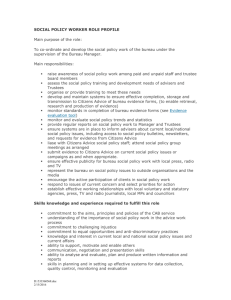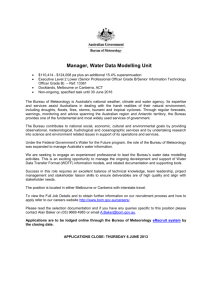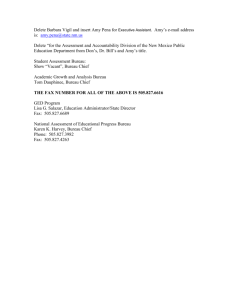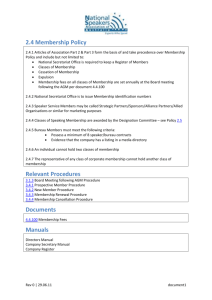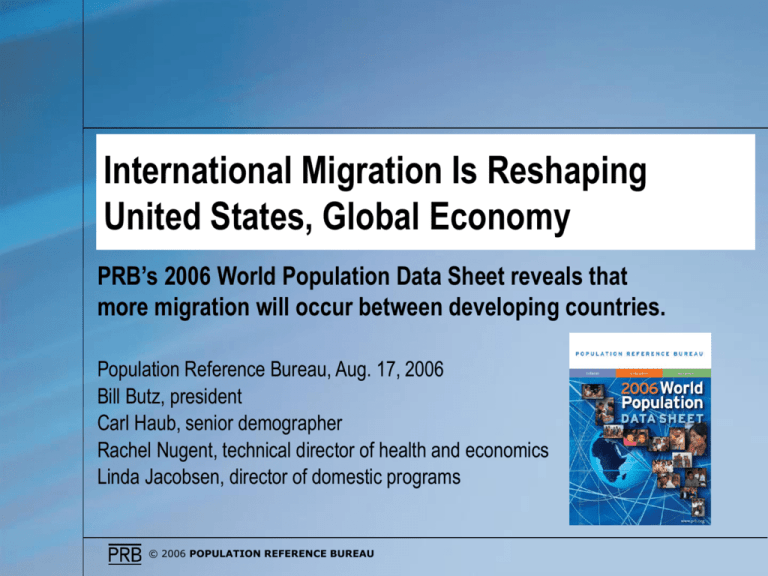
International Migration Is Reshaping
United States, Global Economy
PRB’s 2006 World Population Data Sheet reveals that
more migration will occur between developing countries.
Population Reference Bureau, Aug. 17, 2006
Bill Butz, president
Carl Haub, senior demographer
Rachel Nugent, technical director of health and economics
Linda Jacobsen, director of domestic programs
© 2006 POPULATION REFERENCE BUREAU
In the Developed Countries, There Are Fewer and
Fewer Young People, but More and More Elderly.
Population by age and sex, more developed countries, 2005
Source: United Nations, World Population Prospects: The 2004 Revision (2005).
© 2006 POPULATION REFERENCE BUREAU
The Young Population in Developing Countries
Has Great Potential for Growth.
Population by age and sex, less developed countries, 2005
Source: United Nations, World Population Prospects: The 2004 Revision (2005).
© 2006 POPULATION REFERENCE BUREAU
Global Population Growth:
A Developing-Country Phenomenon
World population, 1950-2050 (projected)
Source: United Nations, World Population Prospects: The 2004 Revision (2005).
© 2006 POPULATION REFERENCE BUREAU
A Long Period of Low Birth Rates in Germany Has
Resulted in Greatly Reduced Numbers of Youth.
Population by age and sex, Germany, 2005
Source: United Nations, World Population Prospects: The 2004 Revision (2005).
© 2006 POPULATION REFERENCE BUREAU
If Current Fertility and Immigration Rates Continue to
2050, Germany’s Population Will Age Dramatically.
Population by age and sex, Germany, 2050 (if fertility and net migration remain at current levels)
Source: Population Reference Bureau projections.
© 2006 POPULATION REFERENCE BUREAU
Foreign-Born Populations Are Generally Rising
in the Industrialized World …
Percent of population foreign-born, Canada, Ireland, and Spain, 1960-2005
Source: United Nations Population Division.
© 2006 POPULATION REFERENCE BUREAU
… But Foreign-Born Populations Are Also
Rising in the Developing World.
Percent of population foreign-born, Gabon and Malaysia, 1960-2005
Source: United Nations Population Division.
© 2006 POPULATION REFERENCE BUREAU
Migration Within the Developing World Occurs
for Many Reasons.
Differences in fertility rates
Economic conditions
Conflict
Rural to urban movement
Ethnic patterns
© 2006 POPULATION REFERENCE BUREAU
Today’s ‘Youth Bulge’ Will Become Tomorrow’s
Labor Force.
Population by age and sex, Pakistan, 2005 and 2050
Source: United Nations, World Population Prospects: The 2004 Revision, CD-ROM Edition, Extended Dataset (2005).
© 2006 POPULATION REFERENCE BUREAU
South Africa Without AIDS Shows a Typical
Developing-Country ‘Youth Bulge’.
Population by age and sex, South Africa, 2020 (under “no AIDS” scenario)
Source: United Nations, World Population Prospects: The 2004 Revision, CD-ROM Edition, Extended Dataset (2005).
© 2006 POPULATION REFERENCE BUREAU
South Africa With AIDS Shows a Loss of
Middle-Aged Persons and Females.
Population by age and sex, South Africa, 2020 (under “medium AIDS” scenario)
Source: United Nations, World Population Prospects: The 2004 Revision, CD-ROM Edition, Extended Dataset (2005).
© 2006 POPULATION REFERENCE BUREAU
The World Is Closer to Meeting the Clean-Water
Access Target Than the Sanitation Target.
Percent of population with access to improved water and sanitation, 1990-2002, and 2015 MDG targets
Source: UNICEF and WHO, “Country, Regional, and Global Estimates on Water and Sanitation” (2004).
© 2006 POPULATION REFERENCE BUREAU
Disparities in Access to Sanitation Exist Across
Regions and Between Urban and Rural Areas.
Source: UNICEF and WHO, “Country, Regional, and Global Estimates on Water and Sanitation” (2004).
© 2006 POPULATION REFERENCE BUREAU
Both Developed and Developing Countries
Create Protected Areas.
Countries With the Highest Share of Their Surface Area Protected, 2006
Venezuela
63%
China, Hong Kong SAR
51%
Zambia
42%
Liechtenstein
40%
Brunei
38%
Tanzania
38%
Source: UNEP World Conservation Monitoring Center, World Database on Protected Areas (2006).
© 2006 POPULATION REFERENCE BUREAU
The Number of Foreign-Born in the U.S. Is at an AllTime High, but Their Share of the Total Population is
Still Below That of 1910.
Foreign-born population, United States, 1850-2005
Source: U.S. Census Bureau.
© 2006 POPULATION REFERENCE BUREAU
Natural Increase Still Accounts for Almost 60% of
Population Growth in the U.S., but the Share From
International Migration Has Been Increasing.
Percent of U.S. population growth due to natural increase and net migration, 1980-2005
Source: U.S. Census Bureau.
© 2006 POPULATION REFERENCE BUREAU
The Largest Share of Immigrants to the U.S. Still Comes
From Latin America, but the Share Coming From Asia Has
Increased Substantially Since the 1960s.
Percent of immigrants admitted to the United States, by region of origin, 1961-2004
Source: U.S. Department of Homeland Security, Office of Immigration Statistics, 2004 Yearbook of Immigration Statistics (2005).
© 2006 POPULATION REFERENCE BUREAU
In 1990, Almost Half of All U.S. Counties Had Less Than 1% ForeignBorn, and Only One-Tenth Had 5% or More.
© 2006 POPULATION REFERENCE BUREAU
Source: U.S. Census Bureau,
1990 decennial census.
By 2000, Only One-Fourth of U.S. Counties Had Less Than 1%
Foreign-Born, and One in Five Had 5% or More.
© 2006 POPULATION REFERENCE BUREAU
Source: U.S. Census Bureau,
2000 decennial census.

